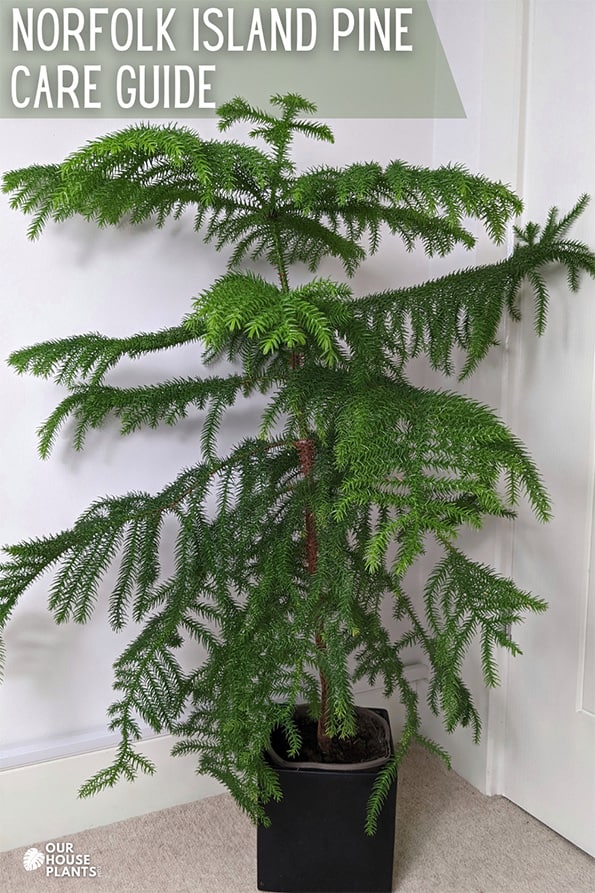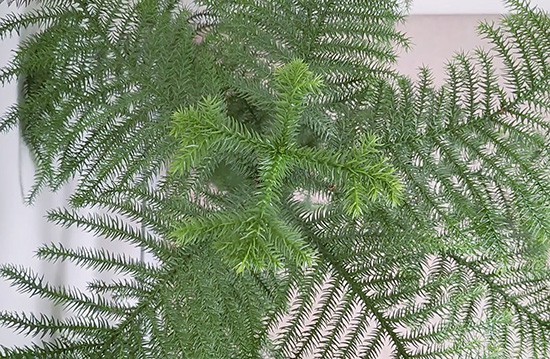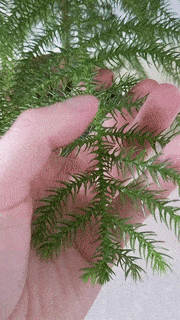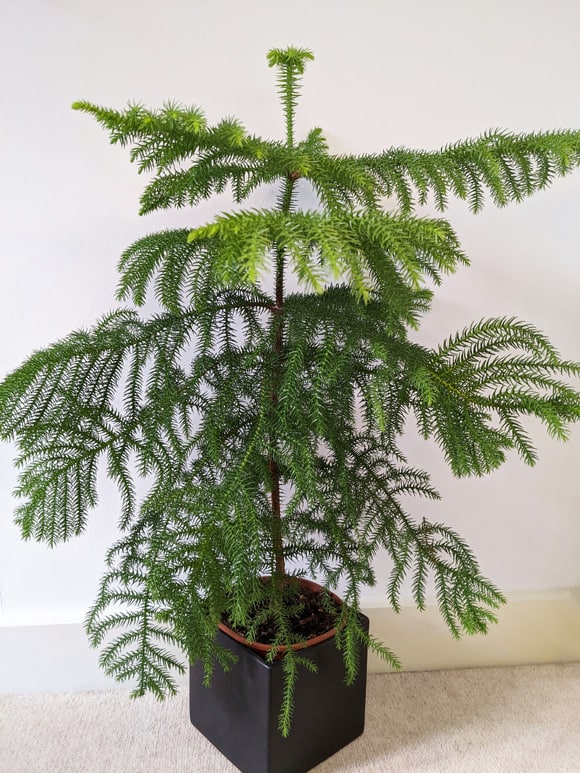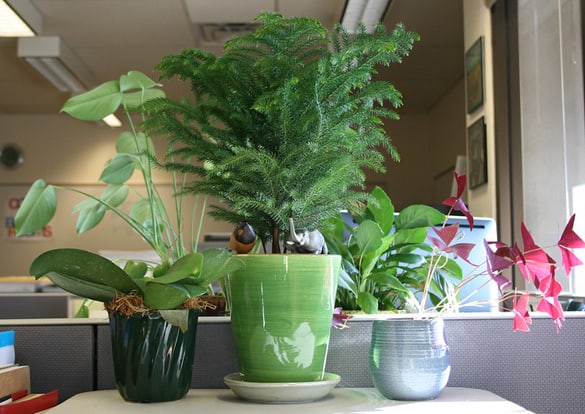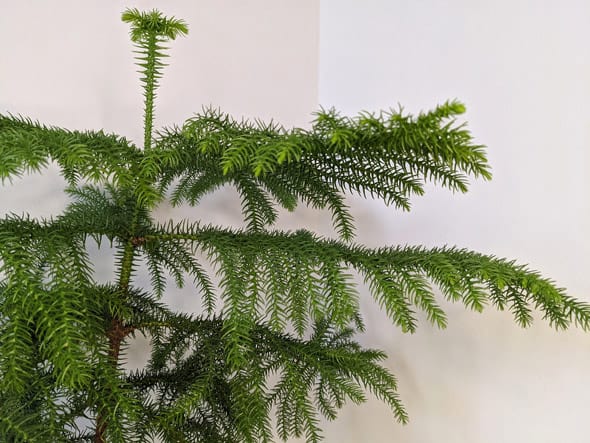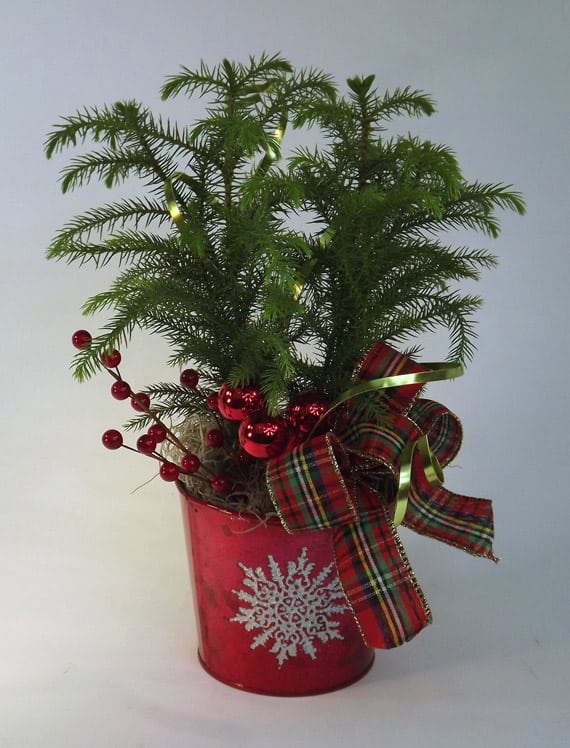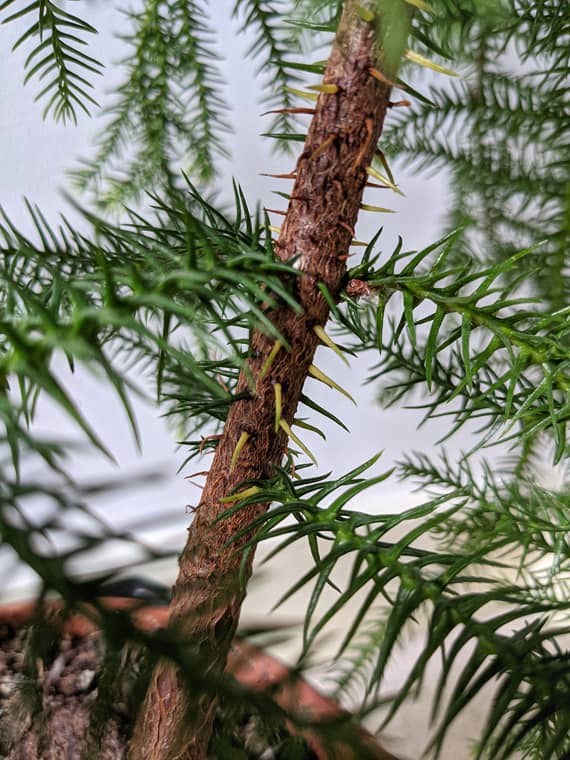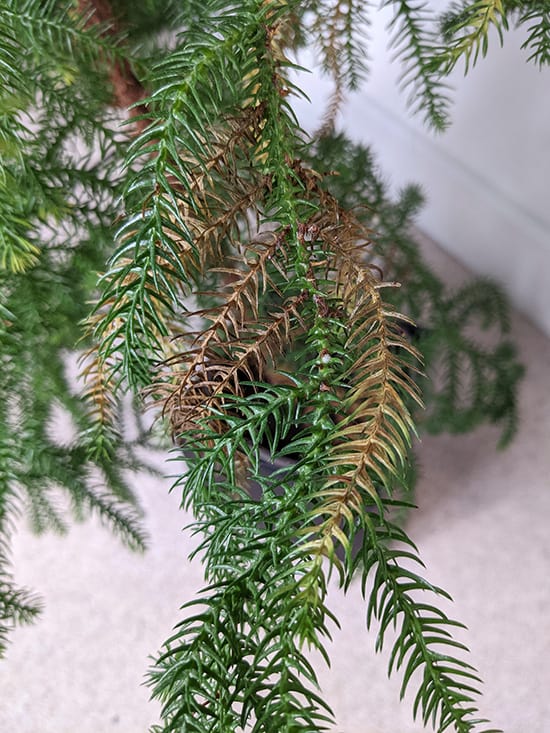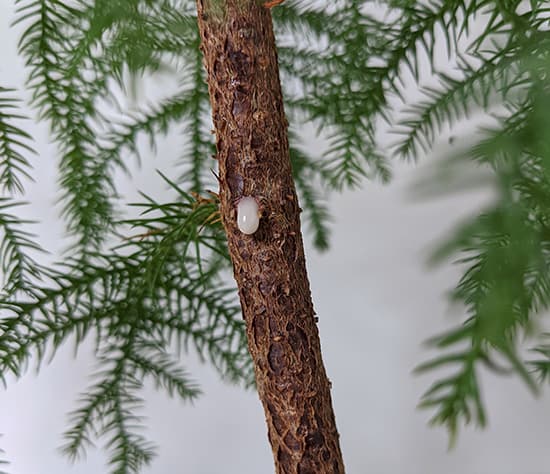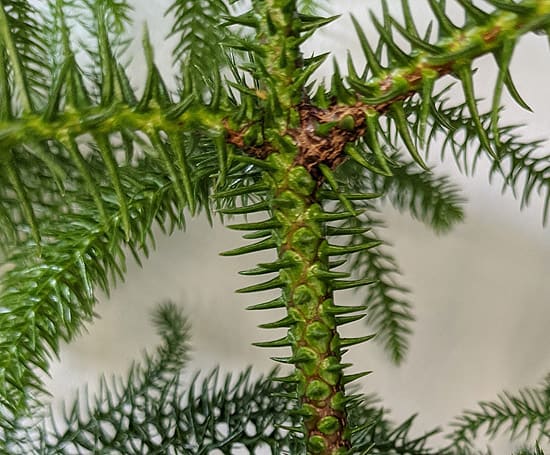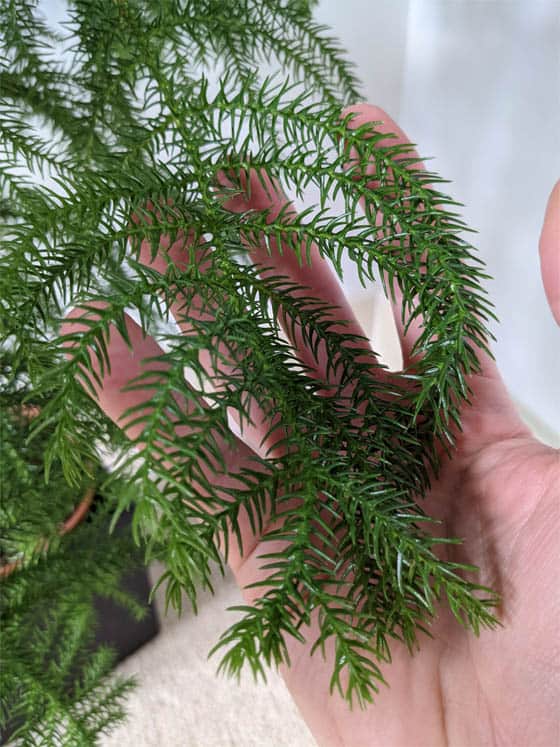Norfolk Island Pine or Araucaria heterophylla is a houseplant you can usually find around Christmas time before it vanishes until the following year.
Some people think the Norfolk Pine needs discarding after the holidays, but this is a very easy indoor plant to keep alive indoors all year round for years.
The Araucaria heterophylla (Norfolk Island Pine Tree) lets you bring some of the forest indoors. It doesn't drop pines / leaves either so it's a very low maintenance house guest.
Although it looks (and smells) like a pine tree and even though it has "pine" in its name, it's not a true pine.
People will often find it being sold as a living Christmas tree covered in glitter or decorations. Although this is a novel and fun use for this houseplant, it can't cope with cold temperatures and should not be left outside. This is strictly an indoor plant for most people.
How do you pronounce Araucaria heterophylla correctly? Say:
ah-roe-KARE-ee-ah
het-ero-phyl-la
Araucaria heterophylla has two common names, the first is the Norfolk Island Pine. This is down to its native habitat, a tiny island in the south pacific ocean between New Zealand and Australia called (can you guess?), Norfolk Island.
The second common name is the Star Pine houseplant, and this is because of the shape of the branches when you look down on it from directly above.
Sometimes called the Star Pine on account of its Star like appearance when looked down on it.
Norfolk Island Pines are also non-toxic, so make an especially great choice for the family home with children and pets. It also makes it into the top 50 houseplants that clean the air list by NASA.
Is this an outdoor plant?
If you live in a part of the world that is mild all year round, then yes. Otherwise, you can put it outside during the summer, but it needs to be brought back inside before it gets colder.
Low maintenance and easy-going, they don't need pruning or much fuss to look their best. The leaves are tough and can be touched without damaging them, making them ideal plants for high traffic areas.
When you feel the needles, you'll notice they're very soft and have a plastic quality, so you might even think they're artificial.
However, if you get up close, you can smell the unmistakable fresh herbal pine smell. Absolutely glorious.
The leaves are very tactile, and even gentle touching releases a herbal pine scent.
There is only one variety available and even then, it can be tricky to find outside of the Christmas holiday season. Other seasonal plants like the Poinsettia are much more common, which is a shame in some ways because with decent care, the Norfolk Pine will easily outlast most Poinsettias.
Did You Know?
The Norfolk Island Pine tree is native only to one island in the entire world; Norfolk Island.
It even features on the island's flag. Exporting this plant is very important for the islanders as trading these plants is one of their main sources of income.
If you need help finding one, search out the big box stores and supermarkets, as they'll often be used as display centerpieces. At other times of the year, you may have to look online at sites like Etsy or eBay.
Despite this relative rarity, the price of these plants is normally pretty reasonable. You can sometimes pick up a discounted bargain if you can get hold of one towards the end of the festive period when retailers want them gone from their stores.
Once you've got one, you'll want to know how to care for it. The good news here is that they're straightforward, follow the care instructions below and yours will be thriving in no time.

Hi, I'm Tom!
If you're like me and enjoy the challenge of growing houseplants and getting them to thrive, then Ourhouseplants can help. This website shares my knowledge and years of growing plants and provides (hopefully) helpful advice on properly caring for your indoor plant friends.
They can tolerate some direct sunlight, especially during the morning or late afternoon hours, but prolonged exposure to intense sunlight may lead to browning of the needles.
They're not what I would call low light plants, but they will accept being set back into a room a couple of feet away from a window. Just expect slower growing speeds and look out for any strange lopsided growth.
Rotate the plant occasionally. This helps prevent the tree from leaning towards the light source and encourages a more symmetrical appearance.
Fortunately, this is a reasonably forgiving houseplant with watering. I've overwatered mine and definitely underwatered it over the years and it never shows any long term damage from this. It's not ideal or how you should look after this plant if you want it to thrive in your care.
Expected Water Frequency?
On average, once a week during the growing seasons and perhaps every one or two weeks in Winter is considered normal.
It wants to be well watered and then allow the top couple of inches to dry out thoroughly before watering again.
How long the drying out process takes will depend on how much light it's getting, the temperature and how big its pot is.
For example, larger plants grown in warm, very bright locations with a small pot, are going to need significantly more watering. Compared to a young plant in a cooler location with less light and a larger pot.
Further reading -
Should You Water Your Plants with Ice Cubes?
Coming from a subtropical country, this plant is going to prefer higher humidity levels. 70% for much of the year is pretty common on Norfolk Island. But they're not true rainforest plants and you don't need to provide this for a healthy plant.
So you can pack away you pebble tray and stop that weekly misting of the tree (they don't work very well anyway)
The average home humidity is normally around 40% to 60% and if you can provide this, then in most cases you don't need to do anything extra.
Norfolk Island Pines (Araucaria heterophylla) adapt well to life as a houseplant.
Watch out for abnormal dry air spots in your home with lower humidity levels. Places next to and above active radiators and air conditioning vents can drastically lower humidity and cause problems. Look out for brown needles at the tips of its branches which can be an early sign of a humidity issue.
Feed occasionally over the growing season, which will help keep the existing needles a lovely shade of green and fuel new growth.
Standard houseplant feed is all you need. I feed mine once every two months or so and it seems perfectly happy with this, although you could do it monthly if you dilute the fertilizer by half.
Did you know?
It might look like one, but this is not a Christmas Tree. It will die if exposed to cold temperatures.
A common mistake with these houseplants is to treat them like you would a Christmas Tree.
I'm repeating myself here, but they're not winter hardy and must not be exposed to anything close to sub-zero temperatures. No lower than 6°C (42°F).
Norfolk Island has a humid subtropical climate and it has a comparable USDA Hardiness Zone of 12b. This means it gets warmish temperatures all year round and you'll get good levels of growth with temperatures somewhere between 15°C (59°F) - 24°C (75°F).
Join me on my YouTube adventure exploring the fascinating Norfolk Island Pine tree.
Large Norfolk Island Pines in some homes can look out of place or untidy, so letting it grow out of control might not be the right option for you. Most people have plants that are just a few feet tall, but what if you want more height than this?
Here's how you can control the height of your plant.
Tall large plants - Bigger pots with lots of space for the roots to grow into will typically mean a bigger plant in a relatively short period.
Short, compact plants - Keeping the roots restricted in a smaller pot will, slow or stop growth almost completely.
What Potting Soil is Best?
Norfolk Island Pines like slightly moist conditions, so a potting mix that retains water without becoming soggy is ideal. Most everyday potting mixes or houseplant blends will be fine.
You could also use peat free mixes as they contain things like pine bark or coconut coir. These materials contribute to both drainage and moisture retention. They add structure to the mix without making it too dense.
How you want the plant to look will determine how you should approach the repotting process.
If you're after a more manageable sized plant then you seldom need to repot it. Potentially once every four years, after the existing soil medium has broken down and no longer holds water and nutrients.
Knock off some of the soil around the root ball and replant in the same container with fresh compost or move it to a slightly a bigger pot.
If you're trying to grow it as a large indoor tree, then you will need to repot it more frequently, potentially once every other year. Make sure you're moving it into a bigger pot each time.
Attempting to propagate a Norfolk Island Pine is tricky, and I don't recommend it. But if you really want to give it a go, you can do it by seed or cuttings.
Seed
This is the most reliable method. Mature older plants will produce large "cones" that contain the seeds you'll need. The main drawback here is that from when they first start to form on the branches, they'll take upward of 18 months to mature.
After which, they'll fall off the plant and start to break apart. You can collect the seed and attempt to germinate more plants.
Simply plant them up into pots containing moist compost. Then place them on a windowsill and keep warm. All being well the seeds should have germinated within a month.
Cuttings
Most of the cuttings won't take. Those that do produce roots tend to never grow beyond the original cutting material. I suspect this is because the branches don't have the ability to grow a full new plant.
The best chance you will have, is to propagate the very central leading tip as this retains the ability to keep producing new upward growth. But in general you'll only ever remove that if you're attempting to restrict the upward growth of your plant through pruning.
Norfolk Island Palm among a number of other houseplants all growing in an office - Credit - Emdot
Young plants tend to grow quite slowly, and then once established and happy, it'll become quite vigorous and grow pretty fast. It's not going to climb to your ceiling like Spider-Man, but it's no snail either. If the container it's in is too small, the plant will have its size stunted until you put it into something larger.
Growing Tip
Growth will always be slower if the light levels are lower, or the roots are restricted in a small(ish) pot. Some people opt for this to limit the growth and stop their plant from taking over.
Indoors, the height will be restricted by either the size of the pot you grow it in, or the height of your ceilings. After many years they can reach 1.8 m (6 ft).
I feel that very tall plants are much more uncommon though, and the fairly slow growth rate means it will take years before it outgrows most spaces.
The bigger issue you'll face is likely to be its spread. It will put out new "levels", each with five separate branches a few times each year and eventually they can fan out and become quite broad. This isn't the plant to grow in a narrow space.
Close up shot showing how the branches grow to give the plant a geometric pagoda-like shape.
Like most conifers, the Norfolk Island Pine doesn't flower. Instead, it will produce the familiar woody seedpods called cones (hands up if you ever collected them on walks for art projects as a child). This is a houseplant grown for its foliage and structure only.
The ASPCA calls this plant the Australian Pine and confirms that it's non-toxic.
Over time (years) the lower branches in particular, will lose vigor and start to droop. They may even start to die off by themselves. You can prune these branches if you want.
When it comes to cutting back the upper branches, it gets more complicated. Part of the Norfolk Island Pine charm is its broadly symmetrical branches and geometric appearance, creating those pentagram shaped layers. As soon as you start chopping off these branches you throw the overall "look" out of balance.
You can prune branches if you want (just avoid the very top growing tips) but I'd be asking what you're trying to achieve before thinking about picking up the scissors.
If you do cut the the central vertical growing stem, there is a good chance it will stunt growth permanently as well as giving the top a "flat" and funny look. Although, if you're at roof height already, you've got no choice but to remove the top section of the plant.
Spray Glitter
To add to the festival charm, it's fairly normal to find these plants sprayed with glitter. However the glitter can block the leaves, which the plant needs for Photosynthesis. If your pine is coated in glitter, wash it off after Christmas is over.
You're more likely to find these houseplants for sale during the festive holidays. Often they could be dressed up to look more seasonal and Christmassy.
But can they be treated like a normal pine tree and decorated from head to roots?
They absolutely can be decorated with bling and even act as an alternative Christmas tree from year to year.
However the branches are not stiff and firm like most pine trees, so it will only accept gentle weight before bending, but if you can look past that, then go nuts with your design skills. Show off your pictures below or tag my Instagram - @our_houseplants
Photo of a decorated Norfolk Pine with Christmas seasonal items Credit to Flower Factor - Blumz by JRDesigns in metro Detroit USA
Branches are browning.
The branches and stem will normally brown with age. The stems age and thicken up and give the plant more support for all the newer growth higher up the plant.
If the browning is happening on the needles or at different parts of the plant then it's a possible sign of sun damage burning your plant. This should be easy to establish if you look back at how it's been cared for. If sun is a factor, move your plant away from this spot or provide some window shading.
Close up photo of some brown stems on a Norfolk Pine.
Brown Leaves / Yellow Leaves.
In the photo above, you can see some yellowing needles. Although classed as an evergreen tree it will still drop old needles after many years.
If this is happening lower down on the plant it's normal and a sign of aging. Older Norfolk Pine's tend not to have needles on the lower stems.
If the yellowing is happening elsewhere, then it's usually a temperature issue (too cold or too hot). Underwatering and overwatering can also trigger some yellowing. Still, this plant is quite tolerant of this, so it would need extreme drought or waterlogging for this to happen.
The photo below shows browning. This can have similar causes but light and placement can also be a factor.
Sometimes not getting enough light for a prolonged period can cause brown needles like this.
Plant parents often like to push plants against something, a wall for example. However, the growth of these plants tends to be more even and balanced, so it's ideally looking for light from all directions.
If they're pushed tight against a wall, one side will be deprived of light, creating lopsided growth; existing growth may also go brown, like you can see above. The fix is to rotate the plant every month or so.
Oozing Sap.
This will often happen when the plant is damaged. For example you might have pulled off a stem or damaged the stems in the leaf.
The plant doesn't tend to drip large amounts, but you can always gently wipe it with a cloth if you're worried about it damaging the surface below.
White sap oozing from the stem.
Droopy Branches.
Usually caused by one of three things.
Random browning in the upper branches / leaves.
As mentioned a few problems up, some browning is normal in the lower branches. It can also happen in the upper regions and is normally called corking. If it's confined to the "joints" where the side branches meet the central stem then it's okay. The browning strengthens areas under weight pressure (see photo below).
Browning on the tips of branches could signify that the humidity is very low, i.e. the air surrounding your plant is too dry.
Browning or corking in random places will likely be caused again by sun damage or some kind of pest. Check the care and placement of your plant to rule out possible sun scorch. If that's fine, have a good look over your Norfolk Island Pine for any signs of pests and treat accordingly.
Brown corking on a Norfolk Pine's branches isn't normally something to be worried about
I'm just being honest here. There is something about the Norfolk Island Pine that isn't attractive. It's unruly, untidy and up close, it sometimes feels like one of those hideous artificial plastic plants.
Just being honest here. There is something about the Norfolk Island Pine that isn't attractive.
A sentiment that I think is shared by many, which might account for its scarcity around these parts. It's just not a popular houseplant. I didn't see one in the flesh for years and for someone who seems to always be in a plant store that's quite a feat.
However, one year, a few weeks before Christmas I spotted one. I bought it more for the novelty and thought it would help me write an article for the site.
Holding the leaves and branch of a Norfolk Island Pine.
Without a clear idea where I wanted to keep it, it ended up regulated into a disused corner of my office. Despite minimal care for a good six months, it thrived. Before I knew it, it had grown several inches. At this point it caught my attention.
Yes, it still wasn't pretty, but the plastic-like needles were suddenly incredibly tactile and inviting. I found you could handle the leaves roughly and still, it was fine. Also the smell. So subtle but vivid from only a gentle brushing. A fresh and herbal pine smell like walking through a forest.
A Norfolk Island Travel Guide Video so you can get a sense of the Norfolk pine origin story and where these plants come from.
There is a rich and detailed back story surrounding these plants. After learning about it, I'm proud to have part of that story living in my home today.
(Article / Gallery) Photo credit of Christmas decorated Norfolk Pine - Flower Factor
(Article / Gallery) Photo credit of Norfolk Island Palm growing in an office - Emdot
